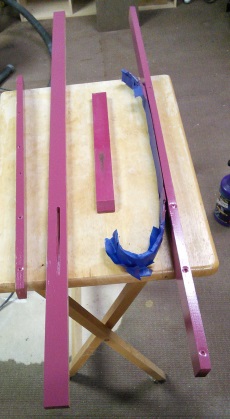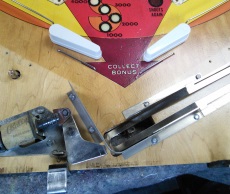Section 1. The Electronics Continued
This game seemed to be possessed when I brought it home. I seemed to be chasing my tail on every issue that came up. Making matters worse, many problems seemed to have multiple causes. Here
is a short list of the issues that I dealt with after fixing the wiring mentioned previously:
1. On boot, the LED diagnostic only gave two blinks.
2. Multiple switched lamps did not work on the playfield and on the backbox.
3. The right flipper machine-gunned.
4. Two wire-rollover switches and eight of the star-rollover switches did not work.
5. One display did not work, one was missing a digit, and three had major burn marks in them.
To be honest, I think most of the issues were the result of the game being stored in a non-climate-controlled environment for the last few months before I got it. Plus, I'm sure that even before
that there probably wasn't a lot of maintenance done to fix non-working lamps or star rollover buttons.
Install All New Pins and Redo Connectors on Lamp, MPU, and Driver Boards
Since I was chasing my tail with some issues seeming to have multiple problems, I decided I should just go ahead and replace all of the .100 sized pins on the MPU, the driver board, and the lamp board. I didn't replace the .156 pins on the driver board as they seemed to be working and in good shape. I figured this would take bad pins out of the equation and doing this helped eliminate alot of the issues. I did end up having a couple of pins where my soldering job was a little suspect, but this was easy to determine and fix.
After replacing all of the pins, I then re-placed all of the .100 connectors. This was time consuming doing all of them, but I wanted to eliminate the connectors and pins as the cause of any problem that I was having. I figured that since this game had been in a non-climate controlled enviornment, this was probably a good idea; and it was, as this helped several of the lamps to work.
On Boot the LED only Flashed 2 Times.
This is one of the nice things about Bally's system, the diagnostic is very helpful in isolating the problem. In this case, it was the 5101 chip that sits at U8. Fortunately, this was already socketed, so all I had to do was replace the chip and viola, the game booted successfully with the flicker and all seven flashes. Now we were cooking. For those wondering, here is a possible list of what is wrong when using the LED diagnostics. A good game should boot with a brief flicker and then seven flashes.
Multiple Switched Lamps Did Not Work
On most games, fixing lamp issues is the easiest task because the logic is so straightforward on Bally games. There is no lamp matrix. Every lamp has a discrete circuit so figuring out the issue is USUALLY pretty easy. But did I say that this game was possessed? Getting all of the lamps on this game working was the most difficult task I ended up having. Every possible problem you could have with the lamps, I did have (except bad decoder chip) and in some cases, I had multiple isses for a single lamp. This link gives a helpful synopsis of how to diagnose Bally lamp problems. I created this to help myself after always having to go back and read notes on the issue. I think it might be helpful to readers also. Just note that I followed the steps on that page. This page gives a list of possible problems, diagnosing techniques, and other helpful lamp information.
In the end, this particular board actually took me a couple of weeks to get totally solved. I've never had lights give me this much problem on a Bally game.


